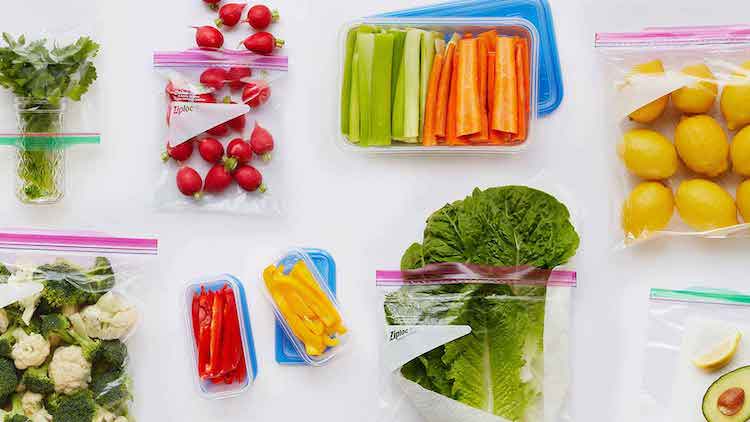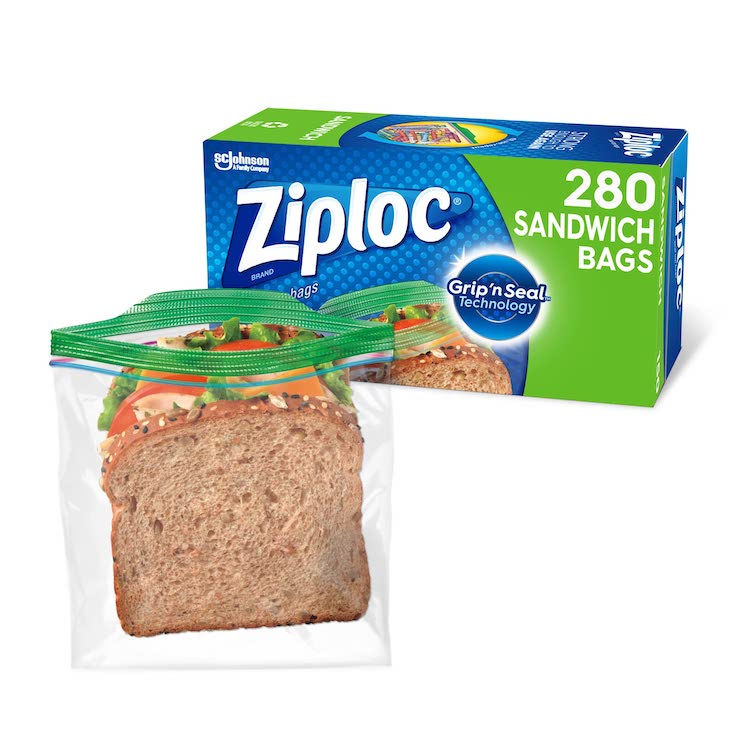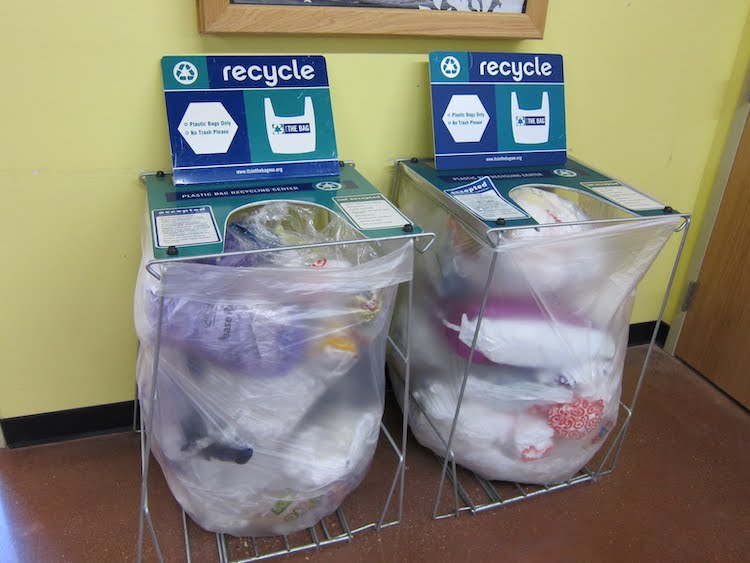Are Ziploc bags recyclable?
The short answer is yes, you can recycle Ziploc bags anywhere that other types of plastic bags and plastic film can be recycled.
Your question may be answered already, but let’s dig a bit deeper into what exactly Ziploc bags are, how and where to recycle them, their environmental impact, and alternatives to using Ziploc bags.

What is a Ziploc bag?
Very simply, Ziploc baggies are the name for any form of resealable food storage bag. Ziploc is a great example of a brand name that became so common that it became the name of the entire category of products. Ziploc is a trademarked brand manufactured by SC Johnson, but your local grocery store will have many different types of resealable plastic bags, and in this article, we’re referring to all of them.
The average American family uses over 500 ziploc bags per year. These things are pervasive, and they’re rarely used more than one time before being tossed in the trashcan. We have grown so accustomed to single-use conveniences that many people never stop to think if they have a better option. Fortunately they do!

What material are Ziploc bags made of?
Plastic food bags are almost always made from polypropylene, including nearly all that have a resealable closure. Polyethylene is another form of plastic that food bags are made of, but they are far less common, and for good reason. Polypropylene (also known as #5 plastic) is generally considered to be the safest in terms of potential chemical leaching. It’s also highly durable.
Aside from minimizing potential health concerns, another main benefit of polypropylene is that the bags are highly durable. There are standards in the plastic industry for durability, and ziploc bags are typically designed to be reused at least 15 times. That’s fantastic, and far higher than more plastic grocery bags which depending on thickness, might not even make it home from the store on the first use. If every plastic storage bag was used even half that many times, we’d massively reduce the amount of plastic ending up in the landfills or oceans.
Where can I recycle Ziploc bags
You can recycle Ziploc bags anywhere that recycles any time of plastic shopping bag or plastic film. They can usually be recycled at designated drop-off locations such as grocery stores, retail stores, and other collection points. Many of these locations have collection bins where you can deposit your plastic bags and film.
The following is a very short list of common grocery stores and retailers that recycle plastic film and bags, including Ziplocs:
- Albertsons
- Harris Teeter
- H-E-B
- Home Depot
- Kohl’s
- Publix
- QFC
- Ralphs
- Randalls
- Safeway
- Sprouts Farmers Market
- Target
- Vons
- Wal-Mart Supercenter
For a complete database of plastic bag/film recycling locations, check out: BagandFilmRecycling.org. You can also check with your local recycling program or waste management agency, as they may have specific guidelines for disposing of plastic bags at your local recycling facilities.
Recycling requirements for Ziploc bags
The only requirements are that the bags are empty, clean, and dry. So dump them out, give them a quick wash with warm soapy water, hang them up to air dry, and then take them in next time you go buy groceries.

How are Ziploc bags recycled?
The following video is a great explainer on how plastic bag recycling works…
Can I recycle Ziploc bags in my home recycling bin?
In almost all cases, the answer is no. you cannot put Ziploc bags (or any plastic bags) in your home recycling bin. Municipal recycling facilities are simply not equipped to handle them, which get caught in conveyor belts and can shut entire sorting facilities down.
Our research turned up one exception though – the borough of Bradley Beach in New Jersey. Beginning in November 2019, residents of Bradley Beach, New Jersey, will be able to recycle plastic bags, plastic casing, and plastic wrap using the household recycling garbage can. This pilot program, created by the Bradley Beach Borough in partnership with SC Johnson, is the first plastic cover household recycling program in the state. Until now, residents had to recycle plastic mulch through store drop-off programs.
“For decades, we have worked to lighten our environmental footprint. It’s who we are. It’s how we operate. And recycling Ziploc bags is just one more example.” – Fisk Johnson, Chairman and CEO of SC Johnson
The program offers a more convenient option for consumers and will serve to increase recycling rates. As part of the partnership, SC Johnson provided the community with educational materials and funding for a collection vehicle and household recycling containers.
Can I reuse a Ziploc bag?
Ziploc bags are designed to be reusable, but the number of times you can reuse them depends on several factors, such as the type of food or item you stored in the bag, the cleanliness of the bag, and how well you handle and care for the bag. The more times you can use a bag before disposing of it the better – if every single ziploc bag was used 10 times instead of 1, that would mean a 90% reduction in the amount of plastic in landfills!
It’s important to handle reused bags more gently than usual when opening and closing, as excessive force can cause the zippers to break or wear out quickly. People who intent to throw it out after a single use don’t really think about it – but you’re going to reuse as much as possible! However, if you notice any signs of wear or damage, especially holes or tears, it’s best to dispose of the bag and use a new one instead.
How to clean Ziploc bags for reuse
To clean a Ziploc bag, make sure to wash it thoroughly with warm soapy water, rinse it well, and let it air dry completely before using it again. I typically use the soft side of a sponge to make sure any food reside is removed, and pay extra attention to getting the corners. Avoid using hot water, bleach, or other harsh chemicals, as they can damage the bag and compromise its integrity.
It is not necessary, and not recommended to turn the bag inside out when washing or drying the bag. This can cause additional wear and tear on the more rigid plastic in the zipper seal of the bag, and isn’t necessary.

When to avoid reusing Ziploc bags
We already mentioned disposing of a bag if you notice any physical damage. Another type of damage you may want to avoid is scratching. This could occur if you put particularly hard or abrasive materials in the bag. If the plastic becomes a little cloudy or has visible scratches, then there’s a possibility that microabrasions will create microplastics. While polypropylene is the safest plastic for food storage, you do not want to ingest any kind of microplastic.
If you have used the bag to store dry foods such as crackers or cereals, and the bag is still in good condition, you can reuse it a few times. However, if you have used the bag to store raw meat or other perishable foods, it’s best to dispose of the bag after use to prevent the risk of bacterial contamination. Perishable food that hasn’t approached its expiration date and isn’t rotting or moldy is fine. But if you see any rot or any mold, or there are any smells or slime on the food being stored – just throw it away. To be honest, warm soapy water *should* take care of it, but it’s really better err on the side of caution with food-borne illnesses!
Alternatives to Ziploc bags
There are a growing number of eco friendly alternatives to Ziploc bags. The following is a list of types of alternatives, there are many options. We’ll write a review of them in the near future.
- Glass food containers
- Beeswrap and other food wraps
- Silicone bags
- Wax paper
- Solid polypropylene containers
- No container at all!
Glass food containers
Glass containers are probably the best thing you could use. Unlike plastics, there is absolutely no possibility of chemicals leaching from the material into your food. Also, if you’re using pyrex glass, you can heat up the same container that you store the food in. You can go straight from the freezer to the microwave without any problem. *Note – do NOT do this with glass that isn’t pyrex, it can explode from a rapid temperature change!
The drawback of glass containers is the possibility of them breaking when dropped on hard surfaces – but many types of glass are shatter resistant.
Beeswrap and other biodegradeable food wraps
Beeswrap is a food wrap material made from a coated fabric (typically cotton). The cotton is infused with natural, food-grade substances such as beeswax, rosin, coconut oil, and jojoba oil. Because of this coating, it acquires properties that are idea in food storage. It is “grippy” so it can be laid over bowls or other containers and attaches to the rim much like plastic-wrap. It is breathable, which helps to prevent mold or bacteria from growing. It’s durable – it can be reused over and over for up to a year before needing to be replaced.
The common drawbacks people complain of is that it is expensive, and has high maintenance. I think both of these are purely in comparison to the alternative – ziploc bags. Standard bags are dirt cheap and have no maintenance, because most people just throw them away after a single use. These complaints only work if you are more concerned about a couple extra dollars a year vs saving the world!
One other drawback of beeswrap is that it’s not appropriate for all kinds of food, especially raw meat and fish, or any wet foods.
When your beeswax wrap has reached the end of it’s useful life, it is 100% biodegradable, so you can throw it right in the compost bin.
Silicone bags
Silicone bags are becoming more and more common as an alternative to plastic-based reusable food storage bags. I saw several different brands on the shelf last time I was at the grocery store.
Unlike plastic, silicone is made chemically from a silica polymer rather than a hydrocarbon polymer. Being a polymer, it has several properties that are similar to plastics in some regards, and different in others. Specifically, silicone is much more durable, a little less flexible, and much more temperature-resistant. It also poses absolutely no threat of leaching into food like plastics can.
One major drawback of silicone bags is that the closures used on them are rarely as easy to use as those on bags made out of plastic. A major benefit is that they can be washed in the dishwasher, and can even be cooked in!
Wax paper
Standard wax paper is yet another alternative to ziploc bags, albeit not a great one in most situations. For some foods you can wrap a piece of wax paper around it and then use a rubber band to hold it together. Think of how the guys at a deli wrap up your sliced meat and cheese! Now that’s plastic-lined paper (not great) but wax paper would have worked just as well.
Wax paper is unfortunately also a single-use material, so we can’t fully endorse it. However, it’s better than single-use plastic that sits in a landfill forever or floats around the great pacific garbage patch, all which creating microplastic pollution and leaching endocrine-disrupting chemicals!
Solid Polypropylene containers
If you’re going to use a plastic container, you may as well use a rigid one if possible! Plastic bags are really designed to be tossed, but plastic tupperware is designed to be washed and reused hundreds or thousands of times. Always look for polypropylene as it’s the most chemically inert of the common plastics.
No container at all!
Do you really need a container for whatever food you’re trying to store? Putting a half a banana in the fridge turns out just about the same whether or not I put it in an air-tight container, so long as it’s only going to be there for a day or two. If you don’t really need to use a container, just don’t!